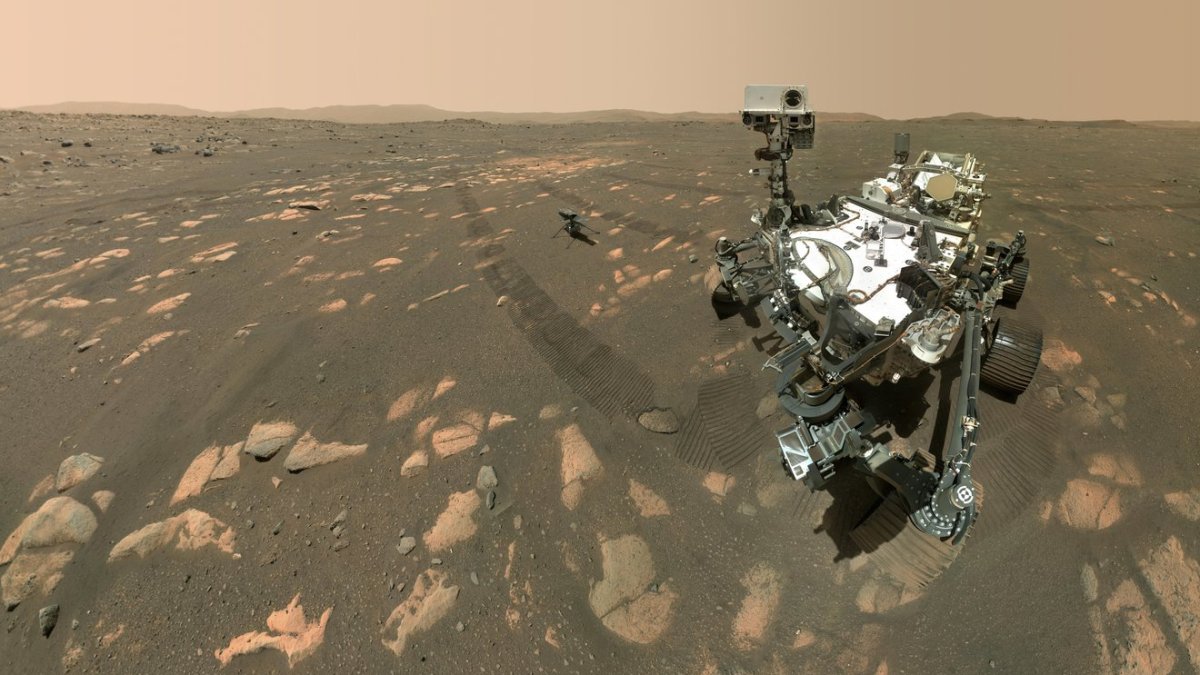On April 6, NASA’s Perseverance rover took a historic photo with the Ingenuity helicopter on the surface of Mars. Now, the Jet Propulsion Laboratory at the California Institute of Technology has revealed part of the process behind Perseverance’s out-of-this-world selfie.
For humans, taking a selfie just means holding a camera at arm’s length, pointing, and pressing the button. But for a robot on another planet, that selfie is a multi-step affair.
Perseverance’s selfie is actually 62 separate images, taken one at a time by the rover’s WATSON camera. That camera is “primarily designed to get close-up shots of rock textures, not wide-angle images,” JPL said.
To bring the smaller images together into a larger image, a robotic arm rotated and maneuvered the WATSON camera to get a complete view of the rover, the Ingenuity helicopter, and their Martian environment, all based on commands entered by NASA scientists.
Zhurong is part of the Chinese Tianwen-1 mission, which was sent into space in July 2020 and whose landing probe reached the planet’s surface on May 15.
The robotic arm that the WATSON camera rests on “acts like a selfie stick,” JPL said, and with so many images combined to create a final product, the arm remains “just out of frame” at the end.
Planning, testing and implementing that process involved a core team of “about a dozen people,” according to JPL. That team included engineers conducting tests at JPL, mobile vehicle drivers, and camera operations engineers who “developed the camera sequence, processed the images, and stitched them together.”
Tracing the many commands involved took about a week, according to a JPL statement.
That week also took place in “Mars time,” following the schedule of a planet with a day roughly 37 minutes longer than one on Earth. The team often stayed up until the middle of the night and caught up on sleep in the middle of the day, experiencing interplanetary jet lag to take the Perseverance selfie together.
The flight will depart on July 20 from Texas.
“What caught the eye the most was getting the wits to the right place in the selfie,” said Mike Ravine, Advanced Projects Manager at Malin Space Science Systems in San Diego. “Given how small it is, I thought we did a good job.”
After each individual image returned to Earth, transmitted from Mars, MSSS image processing engineers put the photos together. After cleaning “the imperfections caused by the dust that was deposited on the camera’s light detector”, the engineers “assemble the individual picture frames into a mosaic and smooth their seams with software”, so that they all look like one more photo big.
While historic in its own right, the Perseverance photo is not the first selfie taken by a rover from another planet. That achievement belongs to the Curiosity rover, which took a black and white image of itself from the surface of Mars on October 31, 2012.
“When we took that first selfie, we didn’t realize they would become so iconic and routine,” Vandi Verma, Perseverance chief robotics operations engineer at JPL, said in a statement from the lab.
The exit ramp of the rover, the rear of the SUV with the red earth of Mars in the background and the uncoupling of the landing module are the first images published by the National Space Administration of China.
Verma helped create that first Curiosity selfie as a host for the Opportunity and Curiosity rovers, in addition to her most recent work on the Perseverance selfie.
According to JPL, because Perseverance’s “selfie stick” turret is 30 inches long, much larger than Curiosity’s 22-inch turret, the Perseverance photo was more difficult to take. JPL had to create special software to avoid collisions between the robotic arm and the rover itself, which are only “centimeters” from each other during the selfie process.
The script the software runs brings the arm “as close to the body of the rover as possible without touching it,” Verma said.
Perseverance’s selfie is also uniquely accompanied by sound, as the rover is the first spacecraft to bring microphones to Mars.
The Department of Science and Environment in Queensland, Australia, released a video captured with a drone showing thousands of turtles congregating on Australia’s Great Barrier Reef during nesting season.
The rover carries an entry, descent and landing microphone, as well as a microphone connected to its SuperCam instrument. Part of its purpose is to help scientists discover any problems that may have arisen on Mars.
“It’s like your car: even if you’re not a mechanic, sometimes you hear a problem before you realize something is wrong,” Verma said.
But a side effect of the microphones is a robotic hum that accompanies Perseverance’s selfie, which, according to Verma, can sound “musical, like a flute” as the pitch changes.
The end result is an extraordinary photo of two spacecraft, on their mission to analyze the geology and past climate of another world.

